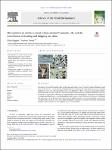Microplastics in surface coastal waters around Plymouth, UK, and the contribution of boating and shipping activities
| dc.contributor.author | Higgins, C | |
| dc.contributor.author | Turner, Andrew | |
| dc.date.accessioned | 2023-11-28T13:10:56Z | |
| dc.date.available | 2023-11-28T13:10:56Z | |
| dc.date.issued | 2023-10 | |
| dc.identifier.issn | 0048-9697 | |
| dc.identifier.issn | 1879-1026 | |
| dc.identifier.other | 164695 | |
| dc.identifier.uri | https://pearl.plymouth.ac.uk/handle/10026.1/21735 | |
| dc.description.abstract |
Microplastics determined in surface water trawls from coastal waters around Plymouth, southwest England, ranged from 0.26 to 0.68 n m-3, with a decrease evident from the lower estuaries of the Tamar and Plym to areas in Plymouth Sound more remote from urbanisation. Microplastics were dominated by fibres of rayon and polypropylene and fragments of polyester and epoxy resins, with fragment concentration demonstrating a significant and positive linear relationship with concentration of floating and suspended matter retrieved by the trawls. Observations are attributed to the suspension of land-based (e.g., treated municipal waste) sources of textile fibres, and the flotation of land-based and in situ emissions of paints and resins from boating and shipping activities. The implied decoupling of microplastic transport based on shape and origin merits further investigation while the more general determination of floating and suspended matter concentration in microplastic studies is recommended. | |
| dc.format.extent | 164695-164695 | |
| dc.format.medium | Print-Electronic | |
| dc.language | en | |
| dc.publisher | Elsevier BV | |
| dc.subject | Coastal | |
| dc.subject | Estuaries | |
| dc.subject | Trawls | |
| dc.subject | Suspended | |
| dc.subject | Resins | |
| dc.subject | Boating and shipping | |
| dc.title | Microplastics in surface coastal waters around Plymouth, UK, and the contribution of boating and shipping activities | |
| dc.type | Journal Article | |
| plymouth.author-url | https://www.webofscience.com/api/gateway?GWVersion=2&SrcApp=PARTNER_APP&SrcAuth=LinksAMR&KeyUT=WOS:001028914300001&DestLinkType=FullRecord&DestApp=ALL_WOS&UsrCustomerID=11bb513d99f797142bcfeffcc58ea008 | |
| plymouth.volume | 893 | |
| plymouth.publication-status | Published | |
| plymouth.journal | Science of The Total Environment | |
| dc.identifier.doi | 10.1016/j.scitotenv.2023.164695 | |
| plymouth.organisational-group | |Plymouth | |
| plymouth.organisational-group | |Plymouth|Research Groups | |
| plymouth.organisational-group | |Plymouth|Faculty of Science and Engineering | |
| plymouth.organisational-group | |Plymouth|Faculty of Science and Engineering|School of Geography, Earth and Environmental Sciences | |
| plymouth.organisational-group | |Plymouth|Research Groups|Marine Institute | |
| plymouth.organisational-group | |Plymouth|REF 2021 Researchers by UoA | |
| plymouth.organisational-group | |Plymouth|Users by role | |
| plymouth.organisational-group | |Plymouth|Users by role|Academics | |
| plymouth.organisational-group | |Plymouth|Research Groups|BEACh | |
| plymouth.organisational-group | |Plymouth|REF 2021 Researchers by UoA|UoA07 Earth Systems and Environmental Sciences | |
| plymouth.organisational-group | |Plymouth|REF 2028 Researchers by UoA | |
| plymouth.organisational-group | |Plymouth|REF 2028 Researchers by UoA|UoA07 Earth Systems and Environmental Sciences | |
| dc.publisher.place | Netherlands | |
| dcterms.dateAccepted | 2023-06-04 | |
| dc.date.updated | 2023-11-28T13:10:55Z | |
| dc.rights.embargodate | 2023-12-09 | |
| dc.identifier.eissn | 1879-1026 | |
| dc.rights.embargoperiod | forever | |
| rioxxterms.versionofrecord | 10.1016/j.scitotenv.2023.164695 |


